March 7, 2014
Air Date: March 7, 2014
FULL SHOW
SEGMENTS

The Crimean Conflict and Energy
View the page for this story
Roughly one third of all Europe's natural gas arrives via pipeline from Russia, and the current standoff in the Crimea has European leaders worried about the reliability of energy supplies. Energy analyst Joe Stanislaw from Deloitte LLP tells host Steve Curwood that energy insecurity may prompt some European countries to explore domestic fossil fuel extraction. (07:05)

Reducing Sulfur, Saving Lives
View the page for this story
Sulfur in gasoline makes automobile engines less efficient and creates more pollutants, which pose a public health threat. The EPA has released new regulations to cut the amount of sulfur in gasoline. Dan Greenbaum from the Health Effects Institute tells host Steve Curwood that the new rules are expected to save money and prevent more than 2,000 premature deaths. (05:00)

Ice Climbing
/ Courtney FlattView the page for this story
For people with the slippery hobby of ice-climbing, cold winter weather is essential. And as Courtney Flatt from EarthFix reports, climate change is making frozen ice-walls more unpredictable in the Pacific northwest. (05:15)

Beyond the Headlines
View the page for this story
In this week's trip Beyond the Headlines, Peter Dykstra, published on ehn dot org notes that the green mountain state, Vermont, is not wholly friendly to green energy, and federal safety inspectors are so overworked their job is impossible. (04:05)

3-D Printing is Green
View the page for this story
3D printers are fairly small machines can make just about any metal or plastic object simply by following precise instructions from a computer. A recent study indicates that 3D printing is good for the environment, can save you money, and could be the basis of many new businesses. Michigan Technological University researcher Joshua Pearce tells Steve Curwood about his team’s unexpected findings. (08:20)

Small Matters: RNA
/ Meisa SalaitaView the page for this story
Life originated from substances that somehow managed to progress from chemical reactions to self-replication. Exactly how that happened, and what exactly was the very first molecule to flip from chemical to biological is a matter of enthusiastic debate, as Meisa Salaita reports in the latest in our Small Matters series. (05:10)
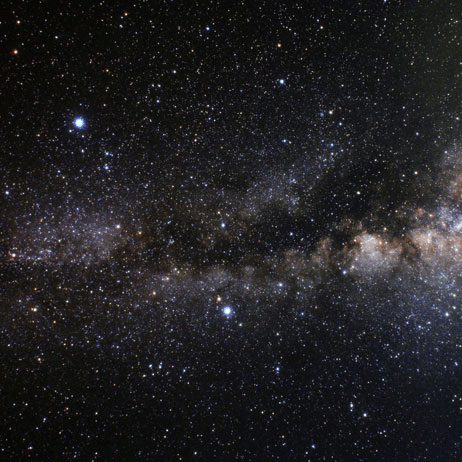
Life At The Speed Of Light
View the page for this story
J Craig Venter is one of the most dynamic figures in genome science. His latest book "Life at the Speed of Light" looks forward to the possibilities for food, medicine and energy, now that humans can create synthetic life and transmit its code across vast distances at the speed of light. (12:20)
Show Credits and Funders
Show Transcript
HOST: Steve Curwood
GUESTS: Joe Stanislaw, Joshua Pearce, Dan Greenbaum, Peter Dykstra, J. Craig Venter
REPORTERS: Courtney Flatt, Meisa Salaita
[THEME]
CURWOOD: From Public Radio International, this is Living on Earth. I’m Steve Curwood.
[THEME]
CURWOOD: In the tense standoff over control of the Crimean peninsula, the hunger for power could complicate possible economic sanctions.
STANISLAW: For Russia the economy is oil and gas. That's the starting point. Oil and gas revenues account for somewhere around two-thirds of the revenues of the Russian economy. Secondly, Europe relies upon Russia for approximately 30 percent of their natural gas supplies.
CURWOOD: Echoes, again, of the Great Game, playing out in the Crimea? Also, what avid ice-climbers can expect as the climate warms up.
POGUE: What we’ll see is that the Columbia Gorge, maybe it’ll go from being once every five years or so to once every 10 years or so, as things warm up. The people that are dedicated ice climbers will just have to be willing to ski in or snowshoe in to get up higher in the mountains where the conditions are colder.
CURWOOD: Power politics, melting ice and more this week on Living on Earth. Stick around.
[NEWSBREAK MUSIC: Boards Of Canada “Zoetrope” from “In A Beautiful Place Out In The Country” (Warp Records 2000)]
ANNOUNCER: Funding for Living on Earth comes from Stonyfield Farm, makers of organic yogurt, smoothies and more.
The Crimean Conflict and Energy

Crimea is a subtropical peninsula jutting into the Black Sea. (Bigstockphoto.com)
CURWOOD: From the Jennifer and Ted Stanley Studios in Boston, this is Living on Earth. I’m Steve Curwood. There’s much at stake in the standoff between Russia and the Western Powers over Ukraine and the Crimea. It’s a power struggle that dates back at least to the Crimean War in the 1850’s when Britain and France fought Russia over religious differences and for territorial hegemony.
Today the question of hegemony is intertwined with energy. Russia is currently the second largest producer of natural gas in the world after the US. And as Western Europe has reduced its use of coal and nuclear power, it has relied more and more on natural gas from Russia, and that complicates any possible economic sanctions - places like Germany need the gas. For more analysis, we turn to Joe Stanislaw, a long-time observer of energy markets and an independent senior advisor to Deloitte LLP.
STANISLAW: For Russia, the economy is oil and gas. That’s the starting point. Secondly, Russia and Europe are intimately linked by pipelines. Europe relies upon Russia for approximately 30 percent of its natural gas supplies, and those gas supplies are contracted out for another 15, 20, sometimes 30 years. Russia needs the European gas market. Almost 90 percent of all Russian gas exports go to Europe. Depending on how you count the numbers and whose numbers you use, oil and gas revenues account for somewhere around two thirds of the revenues of the Russian economy, the Russian government.
CURWOOD: So they have little interest in stopping oil and gas exports I’d imagine.
STANISLAW: That's the point. They need this as much or more than the Europeans need them.

Roughly one third of Europe’s gas arrives via pipeline from Russia. (Bigstockphoto.com)
CURWOOD: This showdown that Russia has set up here, how might that affect their long-term prospects for exporting fossil fuels?
STANISLAW: This is almost...it’s not the same degree, but it’s almost like 1973, ’74, when the Arab oil embargo took place. It’s a warning shot that, geez, geopolitics does play significantly in how global oil and natural gas markets work. So that says to most countries, the US included, how can we become more energy secure? What could happen as a result of this, in Europe in particular, is there are known deposits of shale gas in Germany and Poland, Ukraine, Romania, and other parts and even France maybe that will get the Europeans to revise their policy and the approach to allowing those developments to take place. And if the shale gas is there to the degree that some people think, that is a real change for the Russians in the gas market.
CURWOOD: So Russia's power move here may have put them in a tough business position going years ahead, huh?
STANISLAW: Yes, indeed. That's why I refer to the Arab oil embargo in 1973, ’74. What that Arab oil embargo did is unleashed this concern about the security of energy. As a result of that, the North Sea was propelled into dominance. Companies flocked to the North Sea that wouldn’t have done so beforehand, and that released how many millions and millions of barrels of production still in there. And it opened up areas that it wouldn’t have opened up otherwise where there are more benign governments who had resources but didn’t need to develop them because there was cheap middle eastern oil. That changed the attitudes of many many governments on the supply side, and that was underlying on the demand side too. Policies were put in place to use less of the stuff. In this case you’re going to find more policies to put in place to use less energy and less natural gas.
CURWOOD: It's ironic isn't it, Joe, that the Great Game...the contest for the oil resources in some respects began in Crimea back in the mid 1800s, and now we have a new version of the Great Game.
STANISLAW: Steve, you're absolutely right. The Great Game was Crimea and it was with the, what we all call now the east and the west, Cold War terms, Russia and Great Britain, and we’re right back there again. All things come full circle. This time a little thing called natural gas, and the changing driving force in the Great Game will be technology, and that's why I referred to earlier the issue of maybe the Europeans will change their attitude about this shale gas extraction. That's revolutionized the United States, which was about to become a major major importer of oil, now potentially exporter of oil, and a significant exporter of natural gas.
CURWOOD: Joe, to what extent does Russia depend on US technology to extract its oil and gas resources at this point?
STANISLAW: This is really an underlying critically important issue, Steve. What allowed Russia to reverse their declining oil production in the 1990s was using both software and hardware from US companies, both service and oil gas companies that they did not have access to before the fall of the Iron Curtain, and it changed how companies worked and operate in Russia to allow them to begin to increase what was a declining production curve. Don’t forget by the time the Iron Curtain fell, Russian production, which is well over 12 million barrels a day, had fallen to five or six. But when the wall fell and things began to settle down after four or five years, companies reorganized themselves, brought in western technology and revitalized the production curve in Russian. Going forward that's exactly the same - they need that technology. Equally, they’re sitting on mountains and mountains of shale gas which they haven’t even started to touch yet. And the same with some hard to extract oils that requires a lot of technologies that are called western technologies which they need to access those flow rates. So the way the world works, this is one big interdependent world. Their access to our technology is as critical to their energy industry as the access to the market they want to sell their energy to.
CURWOOD: So therein lies a critical sanction the US could impose, perhaps.
STANISLAW: It is, without question, but also it’s a driving force that goes back to just after World War II where if goods can't cross borders, armies will. Let’s let the goods flow, and armies won’t cross borders.
CURWOOD: So if the Russian invasion of the Ukraine escalates in the days, months, ahead, how might the prices of oil and natural gas be affected by that?
STANISLAW: Well, so far if you look at the markets, the biggest factor affecting natural gas prices in United States has been the weather where you're sitting in Boston and the whole northeast, the whole east of the United States. In Europe, the price of natural gas has gone up significantly because of fears of potential disruption of supplies for that Ukrainian pipeline. On the oil side, the oil really isn’t an issue here in the same way natural gas is. Oil, I think, moved up maybe a dollar. If you live in the oil market as I have over the past 30 years, a swing of 1 percent is...that's not even a sneeze. The energy markets, both the gas and oil markets, are used to this cyclical up-down behavior. That’s the part of the business, because the energy markets are very political markets and the market actors are used to it.
CURWOOD: Joe Stanislaw is the founder of the JA Stanislaw Group. Thanks so much for taking this time today, Joe.
STANISLAW: Steve, it’s been a pleasure speaking with you. Thank you for having me.
Related link:
Joe Stanislaw
Reducing Sulfur, Saving Lives
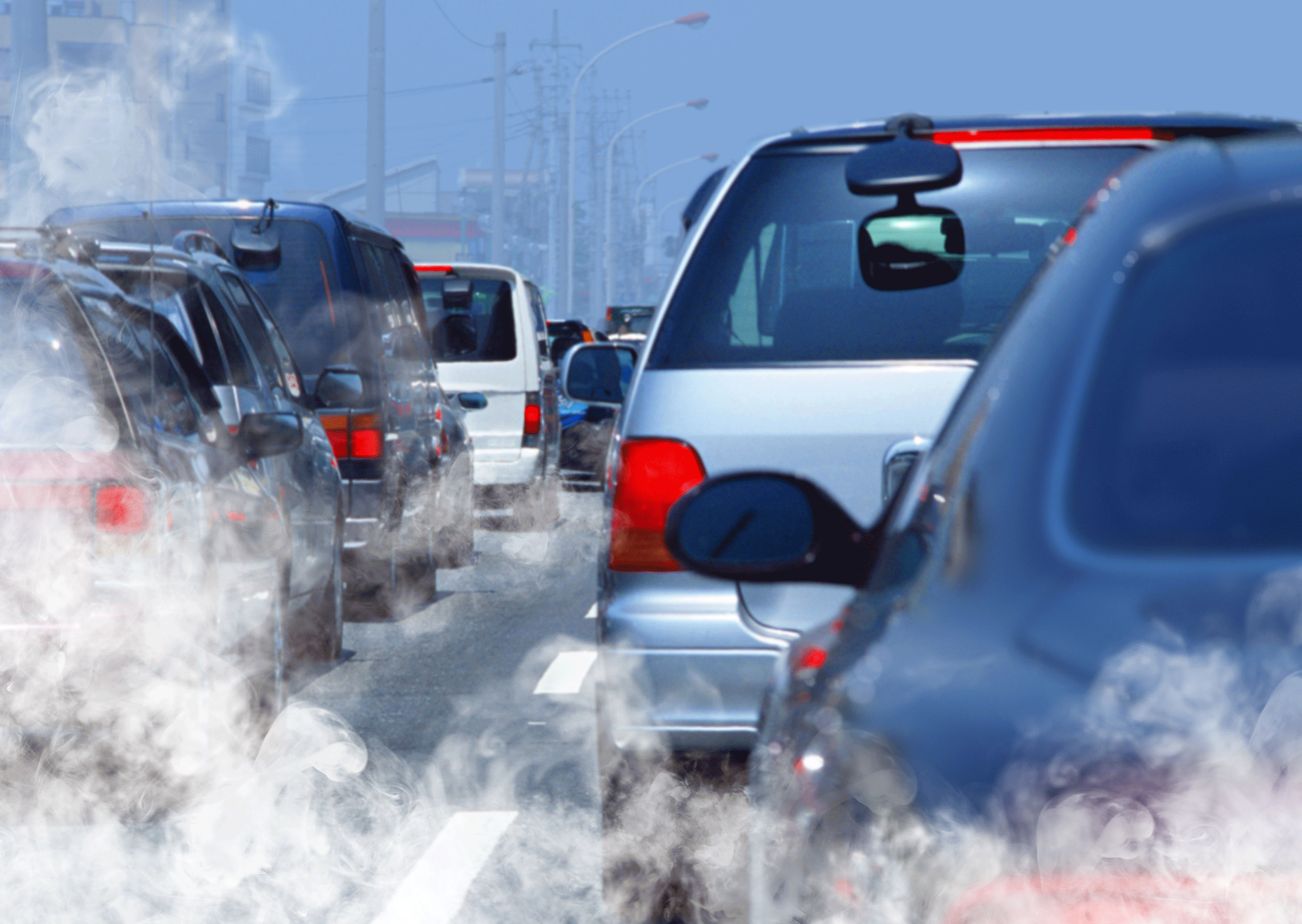
Sulfur in gasoline interferes with a car engine’s ability to control other pollutants like nitrogen oxides which can pose a public health threat. (bigstockphoto.com)
CURWOOD: Burning gasoline creates pollution, and the dirtier gas is, the dirtier the air becomes. To protect public health, over the years gasoline has gotten cleaner and cleaner. In the US, lead is gone from gasoline, as is 90 percent of the sulfur it used to contain. But according to the US Environmental Protection Agency, even that last bit of sulfur can promote deadly pollution, so it has announced new rules to cut most of that remaining ten percent. To get a handle on this new development, we turn now to Dan Greenbaum, President of the Boston-based Health Effects Institute. Dan Greenbaum, welcome to Living on Earth
GREENBAUM: Well, I'm really glad to be here, Steve.
CURWOOD: So what exactly are these new EPA regulations when it comes to sulfur and gas?
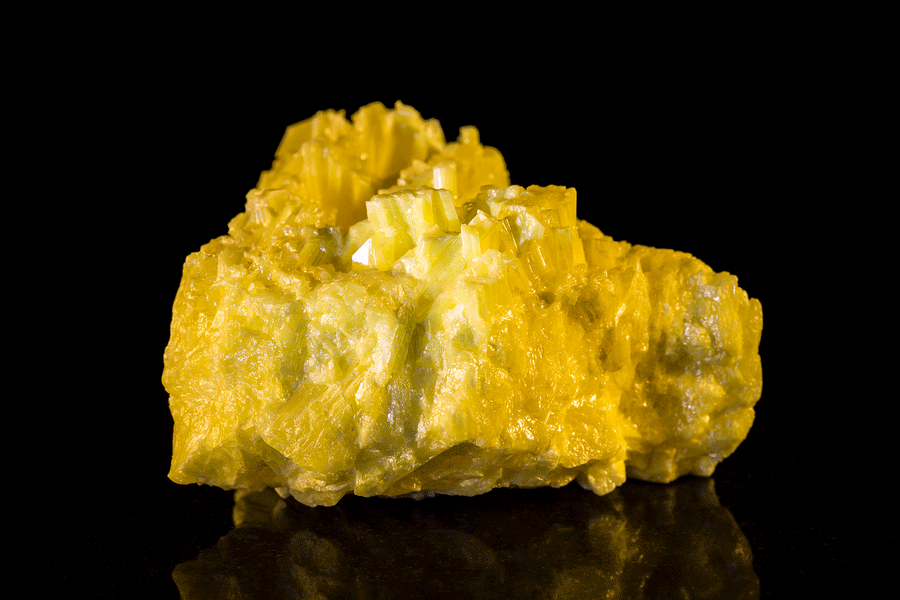
Sulfur is an abundantly available chemical element. (Bigstockphoto.com)
GREENBAUM: Well, a key thing to getting cleaner cars is making sure the fuel is as clean as possible, so the new rules basically set much much lower levels of sulfur in the fuel and that will in turn mean that every control device, every catalytic converter on every one of our cars, even our existing cars, will work better.
CURWOOD: So this is to keep sulfur from clogging these things up?
GREENBAUM: The sulfur will coat the surface, will mean that these converters will not capture the nitrogen oxides and the benzene and other chemicals that would otherwise be coming out of the car.
CURWOOD: So why take up these new sulfur regulations? What's the danger here?
GREENBAUM: Well the real issue here is there are millions of people in the United States every day during the summer in particular face high levels of ozone smog, and ozone is known to cause serious health effects. It can cause people with asthma to have attacks, kids to miss school, people to miss work. It can even on very high days cause premature death. Cars are one of the most significant contributors to that ozone. So these rules are really designed to cut substantially what cars can contribute on an ongoing basis.
CURWOOD: Some have said this will have a huge impact on public health. How true is that?

Asthma sufferers, especially children, will most benefit from the EPA’s new rules reducing sulfur content in gasoline. (bigstockphoto.com)
GREENBAUM: Well, there’s very strong health evidence that my institute and others have created that says that this kind of change in ozone levels will result in thousands of fewer premature mortalities, tens of thousands of fewer asthma attacks, and frankly over a million fewer days of work lost and days of school lost for kids.
CURWOOD: So who are the people that are really going to benefit the most from these regulations, do you think?
GREENBAUM: Number one, you have people with asthma who...and a lot of kids with asthma. There’s much higher levels of asthma among minority populations than others. So on those high ozone days, that means fewer kids having asthma attacks, having to miss school, having to use their inhalers, and that's a real benefit. I think the second issue is that this will reduce the levels of nitrogen dioxide which is right next to roadways. So everybody, particularly poor communities that live near roadways or ports or other areas, is going to see improved air as well.
CURWOOD: The EPA says that this rule is going to cost something less than a cent a gallon to implement, but when we talked to Bob Greco at the American Petroleum Institute, he said he expects it will cost a lot more.
GRECO: We’re disappointed that EPA moved forward with this new sulfur rule. According to our studies, this is not a cost-effective rule. It has an average manufacturing cost of about six to nine cents a gallon. And that’s the cost to manufacture the fuel.
CURWOOD: How do you respond to that?
GREENBAUM: Having participated in setting rules over many years - I used to be the commissioner here in Massachusetts of environment protection - industry will often come up with high estimates of what those costs will be. Aside from any analysis that EPA has done, I’ve seen two quite well done independent analysis that confirm this very very low cost, and these were done not just by nonprofits, but by expert consultants who do this work for the industry itself.
CURWOOD: Now the automobile industry seems to be embracing this. Why?
GREENBAUM: Well, these rules are part of what is now a unified national set of rules. California has already set these tougher standards earlier, so California and the federals are the same. That means the car companies can make one kind of car for the entire country and and that's to their advantage.
CURWOOD: What about the pocketbook here...how will these rules affect what people spend on health care, what people might spend on vehicle maintenance?
GREENBAUM: These rules will have two major impacts on the pocket book. First of all, it will mean that parents have to take their kids the hospital on high pollution days will not have to do that. That's going to save individuals real money and the society real money. And on top of that, these rules are partnered with a set of rules are substantially improving fuel economy for every vehicle, so what we're going to have in 2017 and 2025 are cars that are dramatically cleaner and take far less gas to go a mile.
CURWOOD: Dan Greenbaum is President of the Health Effects Institute. Thanks so much for coming in.
GREENBAUM: I'm really glad to do it, Steve.
Related links:
- EPA on the New Sulfur Rule
- American Petroleum Institute
- Health Effects Institute
[MUSIC: Kris Bowers “#The Protester” from Heroes & Misfits (Concord Music 2014)]
CURWOOD: Coming up...unpredictable weather and climate change threaten a winter ritual. Keep listening to Living on Earth.
[CUTAWAY MUSIC: Wes Montgomery: “Beaux Arts” from So Much Guitar (Original jazz Classics Reissue 2013)]
Ice Climbing
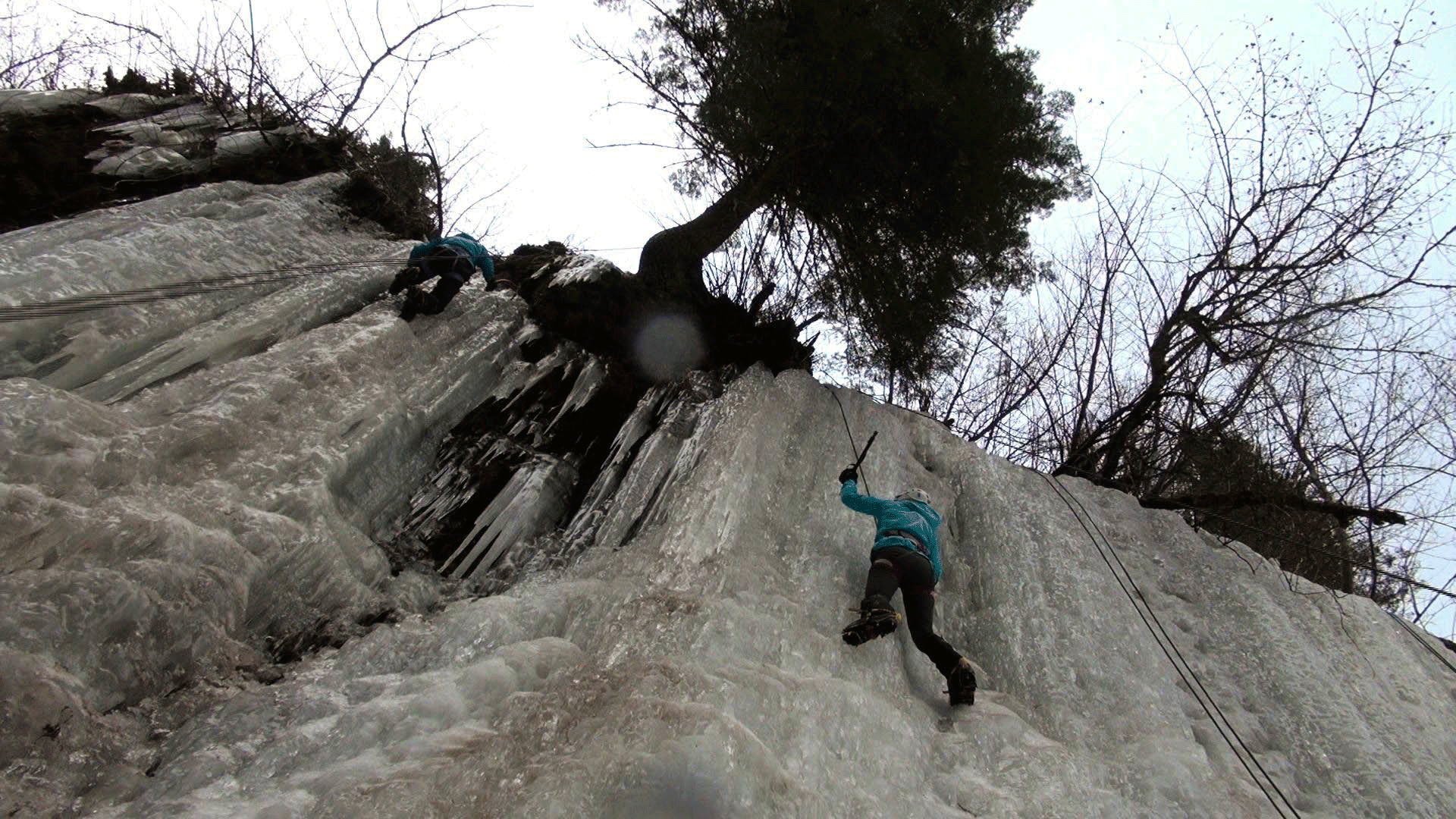
Freshmen Laura Rey and Emma Massie are on their first ice-climbing trip. Both want to continue ice climbing in the future. Some outdoor recreationalists are worried that climate change could threaten some ice climbing destinations. (Courtney Flatt)
CURWOOD: It's Living on Earth, I'm Steve Curwood. In the central and eastern United States, this has been the winter that refuses to end. But these past few months have been warmer than usual for much of the rest of the world, including the Pacific northwest region of North America. The changing weather offers folks in Washington state who love ice climbing fewer opportunities to practice their slippery sport. So that is why, when Courtney Flatt of the public media collaborative EarthFix, heard that a remarkable ice wall near Walla Walla, Washington had frozen up nicely, she clamped on her crampons and headed out.
[RIVER FLOWING]
FLATT: High up in Washington’s Blue Mountains, behind trees and across the Touchet River, is what locals call the Weeping Wall. Water seeps through the permeable basalt and can freeze on the cliff’s moss-covered face. When the conditions are right, that creates a curtain of ice that is irresistible to ice climbers.
[CLIMBING SOUNDS]
FLATT: Today a group of Whitman College students are taking turns scaling the 50-foot wall.
Brien Sheedy directs Whitman’s Outdoor Program. He’s been bringing students here to climb the Weeping Wall for 13 years.
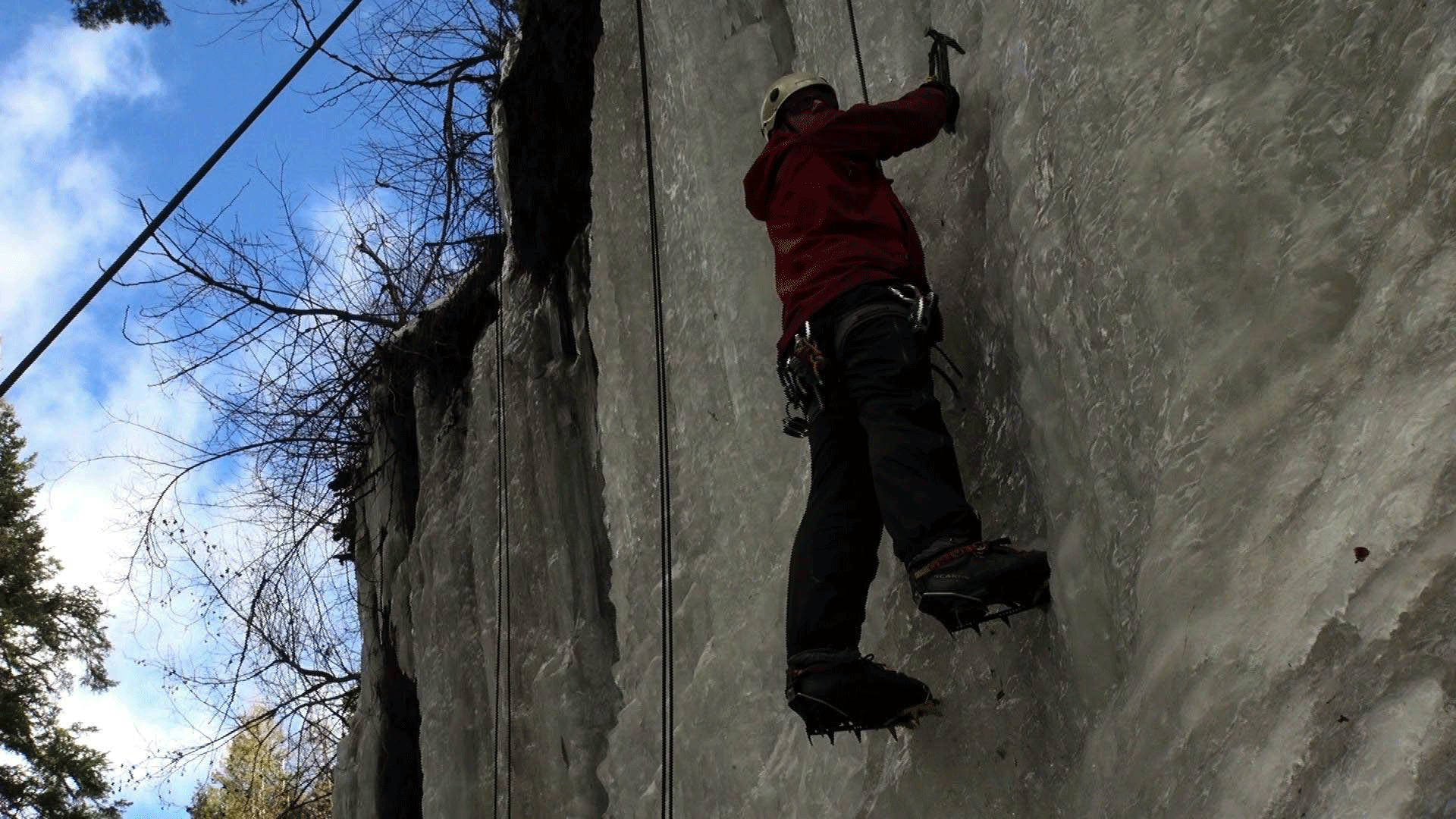
Brien Sheedy, director of Whitman College's Outdoor Program, teaches the students the basics of ice climbing. Sheedy and fellow climbers have anchored bolts to the top of the cliff so that climbers can use ropes to climb the ice face.
SHEEDY: I used to be able to put trips on the schedule when I first started at Whitman College leading groups here. But then the last several years it’s been so unpredictable that we say that we’re going to do ice climbing at some point in the winter, but that it’s going to be condition dependent.
FLATT: Conditions like the right amount of water and cold enough temperatures. Kevin Pogue is a professor at Whitman College. He teaches a class on weather and climate and sometimes helps lead ice-climbing trips with Sheedy. He says temperatures must be cold for an extended time to be able to safely climb the ice.
POGUE: We basically need to get temperatures for a week where low temperatures - it’s in the single digits or low teens, and where it never gets above freezing during the day.
FLATT: Pogue says those conditions could be harder to come by as climate change causes winter temperatures to warm. The region has had a slight warming trend since 1990. That’s according to NOAA’s National Climate Data Center. Pogue says fewer and shorter cold spells means fewer years where the Weeping Wall – and other ice waterfalls in the Pacific Northwest – will form.

Whitman College freshman Laura Rey makes her way up the Weeping Wall, outside Dayton, Wash. This was Rey's first ice climbing trip. (Courtney Flatt)
Take, for example, the Columbia River Gorge. Pogue says ice climbers swarm to this area bordering Washington and Oregon when the gorge’s hundreds of waterfalls freeze. That tends to happen about every five years.
POGUE: What we’ll see is that the Columbia Gorge, maybe it’ll go from being once every five years or so to once every 10 years or so, as things warm up.
FLATT: That could mean ice climbers have to search higher in the mountains for climbing destinations. The people that are dedicated ice climbers will just have to ski in or snowshoe in to get up higher in the mountains where the conditions are colder.
FLATT: With that, brings a whole new set of skills. Plus avalanche awareness. Like ski resorts manufacture snow, it is possible to manufacture ice. But it’s more difficult. Conditions must be colder, for one thing.
One of the premiere ice climbing locations in the U.S. to manufacture ice is Ouray Ice Park in southwestern Colorado. 78 feet of pipe run along the top of a canyon. The pipe sprays water onto the rock walls nightly. That creates 250 climbing routes. Kevin Koprek manages the park. He says climate change is a concern for the ice climbing industry. Koprek says the ice park is in the process of installing equipment to monitor temperature and UV rays in the canyon.
KOPREK: We’d like to move forward having as much information as possible and try to identify trends and use that information as we develop practice and policy operating the ice park.
[ICE CLIMBING]
FLATT: Back at Washington’s Weeping Wall, Brien Sheedy – who’s climbed Mount Everest twice – says one of the best parts of this climb is its accessibility. You can see it from the side of the road on the drive up to Bluewood Ski Area.
Sheedy says, if the ice doesn’t form here as often, he may take students on more trips to climb ice in crevasses on Mount Baker. That’s about a seven-hour drive from the college. The Weeping Wall is about 45 minutes away. On this day, the warm weather makes the climbing easy. And wet.

(Courtney Flatt)
SHEEDY: I think this might be it because we’re going to lose an awful lot. We would need another prolonged one to two week cold spell to get it to form back up again.
FLATT: The students on this trip are hoping to see that cold spell roll in. This is freshman Emma Massie’s first ice climbing trip. Her clothes are soaked from the water that’s dripped from the ice wall. But the conditions aren’t going to keep her away.
EMMA: So normally when climbing season is over, slash winter happens, you can’t rock climb outside. But this opens up a whole new winter sport.
FLATT: She just hopes climate change doesn’t get in the way of her plans.
I’m Courtney Flatt outside Dayton, Washingon.
CURWOOD: Courtney reports for the public media collaborative, EarthFix.
Related link:
Earth Fix
Beyond the Headlines

(bigstockphoto.com)
CURWOOD: Off now from Evergreen state to the Peach state, for a trip beyond the headlines.
Peter Dykstra's our guide. He's the publisher of DailyClimate.org and EHN.org - Environmental Health News - and he joins us on the line from Conyers, Georgia. Hi there, Peter, what's shaking this week?
DYKSTRA: Hi, Steve, I'm going to start you off with a story from Vermont where there’s a long storied history of battling against what we call dirty energy, and the most recent example of that is, of course, Bill McKibben and this campaign against the Keystone XL pipeline.
Lately though, we’ve seen something different, where Vermonters aren’t giving a free ride to “green energy,” either. Dave Gram’s a reporter for the Associated Press. He covers Vermont, and he describes a place that’s a haven for solar jobs where the lone nuclear plant is shutting down after years of public opposition, fracking was banned outright by the legislature and governor...the Green Mountain State is pretty green. Local opposition recently however killed two windfarm proposals, the legislature turned down a wood-burning power plant proposal, and there was even opposition to a solar array that drew a big crowd of opponents to a hearing recently.
CURWOOD: So Vermonters wanting to protect their scenic vistas, Peter, or maybe some “Not In My Backyard?”
DYKSTRA: Or maybe both, and with things like the wood-burning power plant, there really are some real environmental concerns, but who would have thought Vermont would be the place where alternative energy would see such a tough time?
CURWOOD: Who indeed? What else do you have for us?
DYKSTRA: Well, are you as bad at math as I am?
CURWOOD: Depends how bad you are.
DYKSTRA: I’m pretty bad, I’m going to assume you’re bad at it, too, so here goes. One of the casualties of the tight economy and the push to streamline government, is that we’re seeing safety inspections really cut back - environmental inspections, workplace safety, food safety inspections - they’re all getting squeezed. The people responsible for checking on our safety have ridiculous workloads. We flagged a story in the Des Moines Register this week where they looked into a few examples of this going on in Iowa. There was one state inspector they singled out responsible for 4,500 building inspections for asbestos every year. One person, 4,500 inspections.
CURWOOD: One person, 4,500 inspections in a year?
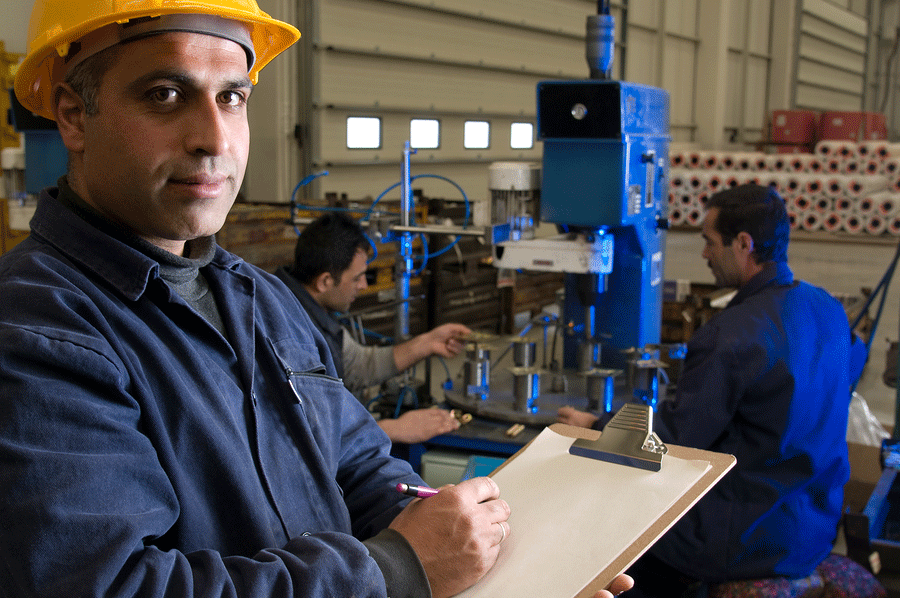
A government inspector at work (bigstockphoto.com)
DYKSTRA: Yes, so I got the calculator out and figured out how realistic or how absurd this was. This poor soul’s workload...they work forty hours a week, maybe two weeks vacation, maybe count in 15 holidays or sick days. That’s 47 work-weeks a year for 4,500 inspections, and that works out to 25 minutes per inspection. So in that frame of 25 minutes, you have to go to the inspection site, you have to travel back from the inspection site, you have to do the inspection, you have to do the paperwork and everything else that’s involved and obviously, that’s something that physically can’t be done. Taxpayers are paying for this, they’re expecting that our health and safety is protected, and it’s a job that’s absolutely impossible to do given the workload, and staffing and time constraints. There are examples of this all over the country.
CURWOOD: So that would suggest that safety inspections have holes big enough to drive a truck through.
DYKSTRA: Yes, unfortunately it also suggests that if you drove a truck through one of those holes, the inspectors would never notice.
CURWOOD: Ok, before you go, Peter, what’s on the calendar this week?
DYKSTRA: We’ve got a really important “what-if” on the calendar because its was 20 years ago this month that Ukraine started to get rid of its nuclear weapons. The Soviet Union had broken up. What was left behind in the Ukraine was the world’s third-largest bomb stockpile. They had more control over nukes than Britain and France, and China combined. Then along came a deal brokered by Boris Yeltsin and Bill Clinton. Other world leaders were involved and they persuaded Ukraine, this newly-independent nation to give up all of its nuclear weapons. The first shipment left in March 1994, 20 years ago, and Ukraine eventually became completely nuclear free.
CURWOOD: And the “what-if” would comes into play if those nukes were in the middle of the current conflict, huh?
DYKSTRA: Exactly. And what the Ukraine got in return for giving up its nuclear weapons was a promise from Russia that Russia would never encroach on Ukrainian territory, and obviously that’s not been going well lately.
CURWOOD: Yes, that’s certainly an understatement. Peter Dykstra is the publisher of Daily Climate.org and Environmental Health News - EHN.org. Thanks, Peter.
DYKSTRA: Thanks a lot, Steve. Talk to you soon.
CURWOOD: And you can find more details of these stories at our website, LOE.org.
Related link:
Vermont Loves Renewable Energy Except When It Arrives
[MUSIC: Steely Dan “Royal Scam” from The Royal Scam (Warner Bros 1976)]
3-D Printing is Green
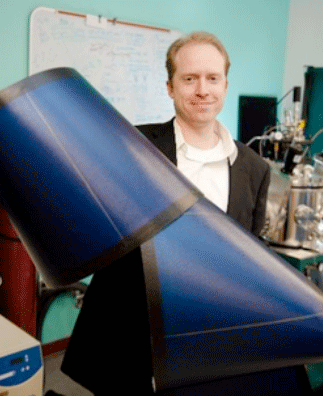
RepRap v.2 'Mendel' open-source FDM 3D printer. (Wikipedia)
CURWOOD: Back before the industrial revolution, if you needed some thing, you or someone else would make it by hand. Then along came the production line and big machines that could mass produce items quickly and cheaply. And now we are headed back to future with so-called 3D printing, where a fairly small machine can make just about any metal or plastic object simply by following precise instructions from a computer. A team at Michigan Technological University has studied the possible environmental and the financial benefits of 3D printing. Joshua Pearce led the research and explains the surprising results.
PEARCE: So a 3D printer is a device that allows you to manufacture three dimensional objects from long strings of spaghetti-like plastic. The hot end melts the plastic as it’s moving over a surface and it traces out just a two-dimensional image the same way a normal printer works. But what makes three-dimensional printers different is the head then moves up a fraction of a millimeter and repeats the pattern again. And by doing this again and again you develop layers of material until you make a three-dimensional object, and that can be extremely complex with intricate designs both on them and within them. There are high-end printers that can basically fabricate anything that you can think of, though the ones that we did the study on - and the ones I think are of interest to most consumers - are currently only able to print in plastic. The open-source models cost less than 500 dollars, and they can still make quite complex objects.
CURWOOD: So, tell us about your study. How did you figure the environmental impact of this?
PEARCE: We choose three relatively common everyday objects. The first was a child’s toy. It’s kind of an intricate stacking block. The second was a spout you use to water your garden. And the third was a juicer for making, say, orange juice in your kitchen. So these would be common products that would be readily available on the web and in most stores, and could be produced with the currently available low-end plastic 3-D printers that you could have in your home. And we did a complete life-cycle environmental analysis of them to determine what environmental impacts of producing objects were and compared them to conventional manufacturing.
CURWOOD: OK. And so what exactly did you find?
PEARCE: We found substantially reduced environmental impacts from making them at home. And this was somewhat surprising because one of the benefits of large-scale manufacturing is you can drive down the cost, and part of those costs, the production costs, comes from technical advantages. It makes a lot more sense to, say, melt a bunch of plastic in a large volume container, so you have a large volume in a small amount of surface area where the energy’s escaping. Yet, when you’re making things with a 3-D printer, your melt volume is very tiny. And so your surface area is larger and you’d expect more losses. We found the environmental impact was cut by about half, between 40 and 64 percent, depending on your settings and the type of object you were looking at.
CURWOOD: So wait a second. Why?

Researcher Joshua Pearce with laminated photovoltaic panels in his Michigan Tech lab (Michigan Technological University)
PEARCE: The savings come from a couple of places. One is the transportation. So we assumed that the objects were manufactured in China and shipped to the US. So you have that reduction in transportation embodied energy. If you make something at home, you don’t have to transport it anywhere. The biggest savings though came by something that the 3-D printers can do that normal manufacturing methods can’t, and that’s you can make intricate designs within the shape of the object. So you don’t have to have a completely solid object in order to have a structurally sound object. You can, for instance, make a honeycomb structure, within, say, the juicer, that you just couldn’t do by any other method.
CURWOOD: So you’d have the strength, but not the weight, not the materials.
PEARCE: That’s right. So you don’t use as much materials, then that directly kind of takes off the bottom line for both embodied energy and emissions that come from making the object.
CURWOOD: Now, some people listening to us might say, well, plastic being green is kind of counterintuitive.
PEARCE: Absolutely, so one of the environmentally friendly aspects of 3D printers is the most popular polymer that we use now, it’s polylactic acid, or PLA, and that’s an organic-based polymer that is derived from corn. So not only is it recyclable, it’s also compostable. As far as green materials go, it’s extremely green to begin with. I think as 3D printing catches on and more and more people begin using it, I think we’ll be doing direct recycling. Our group has created a recycle bot, which is basically a little tool that turns waste plastic into long strings of spaghetti that you then feed into the 3D printers. And that technology is much less developed than the 3D printers themselves, but it’s coming and it’s coming fast. Not only do we think we can expect people to 3D print things in their home, but I think we’ll start recycling in our homes as well, and radically reduce the environmental impact of things that we use on two fronts.
CURWOOD: Now, what about the cost of electricity? You have to use some power to run that 3D printer. So how economical is it, or even more environmentally sound to print one widget at a time, rather than making those widgets in a giant factory?
PEARCE: Our studies showed unquestionably using very conservative numbers for the energy use of these printers, and they basically don’t use any. It’s essentially the same amount of power draw that you’d have on your laptop. So these are not energy intensive beasts by any stretch of the imagination. To give you a feel for it, if we say the juicer, using less than a kilowatt hour to make it, and that’s a pretty large print. And so a kilowatt hour costs maybe on average in the United States 10 or 11 cents. You’re literally using only pennies of electricity to make most common objects. We’re already using less than half the energy to make an object as, say, a conventional manufacturing process.
CURWOOD: Your team also looked at different forms of energy, particularly solar power. So what about the use of photovoltaic cells to power 3D printers?
PEARCE: One of the unique aspects about 3D printers is it’s a distributed form of manufacturing, and so we started to think a little bit about what that meant in terms of energy use, and it couples very nicely to a form of distributed power generation. And our group has already developed two separate types of solar powered 3D printers. One was for schools in the developing world, and the other one can fit literally into a suitcase. And so it actually couples very nicely. So a small module produces enough solar power to power these RepRap 3D printers, and when you look at the environmental impacts of that, it annihilates what you can do conventionally. It’s a technology that is primed to use a distributive sort of form of generation like solar photovoltaics that turns sunlight directly into electricity.
PEARCE: It’s probably pretty obvious to you, but to someone listening to us it may not be obvious why they would want to have a 3D printer in their home.
CURWOOD: It will depend very much on the type of person you are. So we’re scientists so a lot of what of what we use our 3D printers for is making scientific equipment. And we’ve cut the cost of scientific equipment down by like 99 percent. For us, that’s a very clear no-brainer. For the average homeowner, it’ll be for doing things that they want customized for themselves first, and so it might be medical applications, it might be things that, if they’re really into particular television show or something and they want a customized toy that is not available, they can justify the cost of the printer for making something special for themselves.
CURWOOD: What will be the impact on jobs with 3D printers?
PEARCE: I think we’re going to see both a lot of job destruction and a lot of job creation. On the destruction side, if your business model is currently based on doing mass manufacturing of polymer based products and selling them for a high markup, you’re in trouble because, I think, in the very near future, people, if they don’t have 3D printers in their own homes, they’ll have access to them at, say, a local 3D print shop, and they’ll be able to make those things for themselves. On the other hand, there’s an enormous opportunity for small-scale entrepreneurship, where if you own a 3D printer, you can start to provide enormous value for people in your local community by printing out the things they need and want. Because you can produce it so much less expensively than is currently available, there’s a huge amount of potential for profit.
CURWOOD: Joshua Pearce is a Professor Michigan Technological University where he heads up the Open Sustainability Tech Lab. Thanks so much for sharing your time with us today.
PEARCE: Thank you. It's been a pleasure.
Related links:
- In Sustainable Chemistry & Engineering, ACS Publications, “Environmental Life Cycle Analysis of Distributed Three-Dimensional Printing and Conventional Manufacturing of Polymer Products,” by Megan Kreiger and Joshua M. Pearce
- Pearce Research Group, Michigan Tech’s Lab in Open Sustainability Technology
- Printers for Pearce: An Interview with 3D Printers for Peace’s Dr. Joshua Pearce
- “Getting Started in 3D Printing,” by Lee H. Goldberg
[MUSIC: Andrew Bird “Masterswarm” from Noble Beast (Wegawam Music 2008)]
CURWOOD: Coming up... a leading scientist calls DNA the software of life, and shows how that software can even create life. That's just ahead on Living on Earth. Stay tuned.
[CUTAWAY MUSIC: George Duke: “Let’s Roll” from Face The Music (Big Piano Music 2002)]
ANNOUNCER: Funding for Living on Earth comes from the Grantham Foundation for the protection of the environment. Supporting strategic communications and collaboration in solving the world’s most pressing environmental problems. The Kendeda Fund, furthering the values that contribute to a healthy planet. And Gilman Orday for coverage of conservation and environmental change. This is PRI, Public Radio International.
Small Matters: RNA
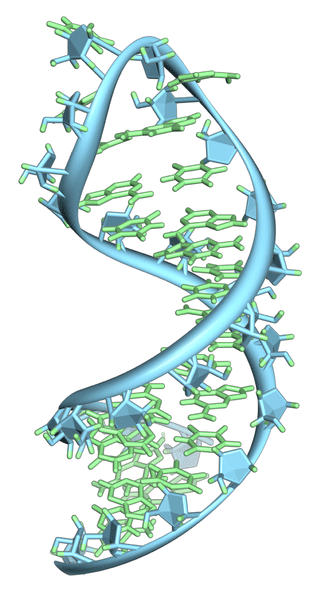
RNA (Wikipedia)
CURWOOD: It's Living on Earth, I'm Steve Curwood. Life is created from a set of building blocks of elements that somehow managed to progress from chemical reactions to self-replication. Exactly how that happened, and what exactly was the very first molecule to flip from chemical to biological is a matter of debate, even contention, as Meisa Salaita reports in the latest installment of our occasional series Small Matters.
SALAITA: Nicholas Hud knows the feeling of competition. But for him, winning doesn't mean crossing a finish line. It means answering a question. And it's kind of a big one.
HUD: We're wondering – where do we come from in the bigger picture of life? Where does all of life come from? I think this is a question that has emerged in every culture of human beings that has ever existed on our planet. It's very, very deep in us.
SALAITA: Hud's a biochemist at the Georgia Institute of Technology and he says that before we can ask where life came from, we first have to ask about where the molecules that make up life came from. Hud believes evolution has a lot to do with the origins of these essential molecules - molecules like RNA.
HUD: Think about the most spectacular display of nature. This could be standing on a mountain, looking down at forests and meadows and the birds flying over. This could be glowing jellyfish moving through the ocean. That’s all made possible by RNA.
SALAITA: RNA is crucial to life. It takes the genetic information encoded in our DNA – the stuff that dictates whether we’ll be blond, colorblind, or prone to having high cholesterol – and translates that information into the proteins that help give us those genetic traits. Hud says it’s this critical role of turning information into substance that makes RNA so fundamental to life.
HUD: That central role has attracted many people to say that perhaps RNA was this first molecule of life. That it can both store information and carry out chemical reactions and so that's why it's really a focus of the origin of life community.
SALAITA: While RNA may be a focus within scientific circles, Hud doesn't think it should be the starting point.

Melissa Salaita
HUD: We're not willing to accept RNA as the first molecule of life because chemically, it's quite difficult to synthesize.
SALAITA: Hud believes RNA came from simpler ancestors. Chemical ancestors that would have had an easier time forming on the early Earth. But on the other side of the Atlantic, Matt Powner, a chemist at University College London, thinks he has a more direct approach.
POWNER: All we need is to get to an RNA molecule.
SALAITA: To Powner, getting to an RNA molecule shouldn’t have to mean starting with something simpler. He believes nature might have had an easier time making RNA from the elements it already had available, rather than having to evolve it from scratch.
POWNER: If we can find chemistry that leads to RNA and that specifically builds RNA that can then begin to replicate, then it would seem that would be a simpler solution to the origin of RNA.
SALAITA: In other words, Powner thinks that if he can find a way to mix chemicals up under the right conditions and get a working RNA molecule, then nature certainly could have done the same, billions of years ago.
So we've got these two scientists with two very different views on how life began, and to further explain the difference, let me use an analogy. Music.
HUD: RNA is the Stradivarius violin. It's perfect.
[Violin Music: Paganini's 24th Caprice – Alexander Markov]
SALAITA: Too perfect, Nicholas Hud says, to have been made right off the bat.
HUD: I'm willing to accept the first violin was as simple as a piece of string strung on a curved piece of wood.
SALAITA: And it's this belief that all complex objects started off in a much simpler state that leads Hud to think that RNA may not have been the first molecule of life. In the lab, he's been able to build simpler molecules with RNA-like behavior with the idea that they changed over time to become the perfect RNA we have today.
But over in London, Powner thinks – hey – if you've got all the materials and the know-how, why not just make a perfect Stradivarius violin from the get-go?
POWNER: We take the molecule apart in such a way that we think about how to build parts of it.
SALAITA: To prove his point, Powner's actually taken some of the simple molecules believed to have been around on the early Earth, and formed some key building blocks that make up RNA.
POWNER: In the exact form that they are in biology.
SALAITA: He's shown that - if given the chance - these molecules can come together to create something as perfect as RNA, a molecular Stradivarius. Of course, we'll never know for sure how life began. But for Matt Powner and Nicholas Hud, it's not so much about being right or wrong. It's more about advancing the debate with sound science.
POWNER: If you keep pushing it forward, you keep pushing forward the interest in that problem, and then you keep asking questions, you keep learning new things. And that's what science is about.
SALAITA: And if the reason we learn new things in science is thanks to a little competition, that can only be a good thing – helping us learn more about our world – and maybe even giving us clues to those very deep questions about where we came from.
I'm Meisa Salaita.
CURWOOD: Our series, Small Matters, is produced by the Center for Chemical Evolution, with support from the National Science Foundation and NASA.
Related links:
- Small Matters
- Wired
- New Scientist
- Chemical Evolution
- Georgia Tech
- University College London
Life At The Speed Of Light
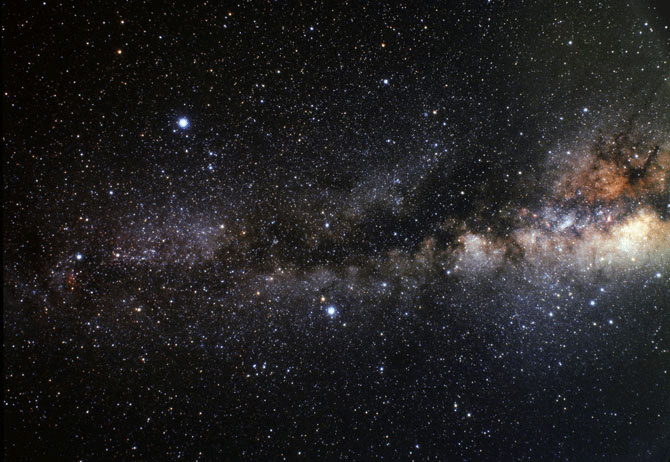
The Milky Way (NASA)
CURWOOD: However life began, there’s no question that where it’s going is beyond the imagination of most of us. But that’s not the case with J. Craig Venter. Craig Venter has been able to literally synthesize life - first in the form of an RNA virus known as a bacteriophage, and then ultimately in the form of full strands of DNA that can reproduce an entire cell. He was one of the decoders of the human genome, but that groundbreaking achievement was merely the start. As Craig Venter contends in his recent book “Life at the Speed of Light”, the future is synthetic. He recalls how the first creation of life in the laboratory opened the door to this future.

Craig Venter (Wikipedia)
VENTER: We started with a small bacteriophage that kills E.coli, and we worked out how to make the synthetic DNA. It took us a couple of years to do that, but when we worked it out we were able to put that synthetic piece of DNA into E.coli, and the E.coli mechanism started reading the synthetic software, making proteins, and the proteins self assembled to form the virus that then killed the bacteria. So we actually describe this process, this situation where the software is building its own hardware. But no one had written large pieces of DNA before. So we had to work out whole new mechanisms for doing that.
CURWOOD: Educate me a bit here. When you talk about synthetic biology you use the term software and hardware. What exactly do you mean?
VENTER: So we consider DNA to be the software of life, much in the same way your computer software controls what your computer can do, only it’s even more so with life because the DNA software codes for the physical entity by making proteins and the proteins help form our cellular structures. So unlike a computer, our software actually leads to a physical structure from its code.
CURWOOD: How much do computers have to do with the work you are doing?
VENTER: Modern genomics would not be possible without modern high-end computing. A thesis of the book is now that the DNA code the As, Cs, Gs and Ts are becoming interchangable with the digital code that of the computer, and we can now go in both directions.
CURWOOD: So, tell me, what was the eureka moment for you when you were able for that first time to synthesize life in the form of this virus, this bacteriophage that could then affect E.coli bacteria?
VENTER: Well, the surprising thing to us was just how chemically made DNA was exactly like naturally occurring DNA in its ability to be read and transcribed. But that was sort of the starting point for this. The eureka moment came several years later in 2010 when we finally worked out how to synthesize a 1.1 million base pair genome. The virus was only 5,300 letters. And boot that up to get a self-replicating cell. The book describes all the trials and dead ends and pitfalls and frustrations and how even having a single letter wrong out of 1.1 million base pairs made the difference between life and no life. So it wasn’t a simple process, and having to work out the chemistry and well as having to work out the biology and how to transplant DNA. And so when we finally got that first beautiful little blue cell in 2010 indicating we had succeeded, it was after a lot of sweat and tears to be sure.
CURWOOD: What was the one innovation out of the many that you has that allowed you to do this? What’s the one thing that you point to yourself that made the critical difference?
VENTER: Well, there were two. One was on the chemical side of constantly improving our tools to synthesize accurate DNA code, but the big breakthrough came through the biological side of learning how to transplant genomes, and that not only laid the groundwork for being able to do this, but it told us a lot about how evolution occurred. And we see evidence for this in the microbes in the ocean and all life forms that instead of just being single genetic changes that led to new species evolving, in many cases it was adding thousands of traits at once by adding an entire new chromosome to a cell, and we were able to recapitulate that in the laboratory in a deliberate fashion. And so I think that was a key to not only understanding biology and life but enabling these next stages.
CURWOOD: What does this nature of life you have uncovered...what does that mean in terms what we might be able to do in terms of finding life elsewhere, well, in first our solar system, for example? Tell me about Mars.
VENTER: Well, the most interesting thing that I learned from my colleagues is we exchange about 100 kilograms of material each year between Earth and Mars. This is from meteor hits and things carried around, and also that Mars had oceans on probably at least two different occasions. And so it’s entirely possible that life on Earth came from Mars originally or vice-versa, but I think life will be ubiquitous in the universe. We find the same chemical basis everywhere we look. Amino acids and nucleic acids are formed sort of naturally, we find them in asteroids coming in. So I think it’s likely we will find it wherever we look in environments we know are compatible with life. The question is how do we get it back, how do we deal with it in the future. One of the proposals we have to use this interchange between the biological worlds and the digital worlds to send life at the speed of light, hence the title of book. And by sending a DNA sequencer to Mars, once we get down to these deeper layers, if there’s life there, we could just sequence the DNA of those microbes and send them back to Earth in as little as 4.3 minutes, and then recreate them using our synthetic genomic tools in a secure lab here.
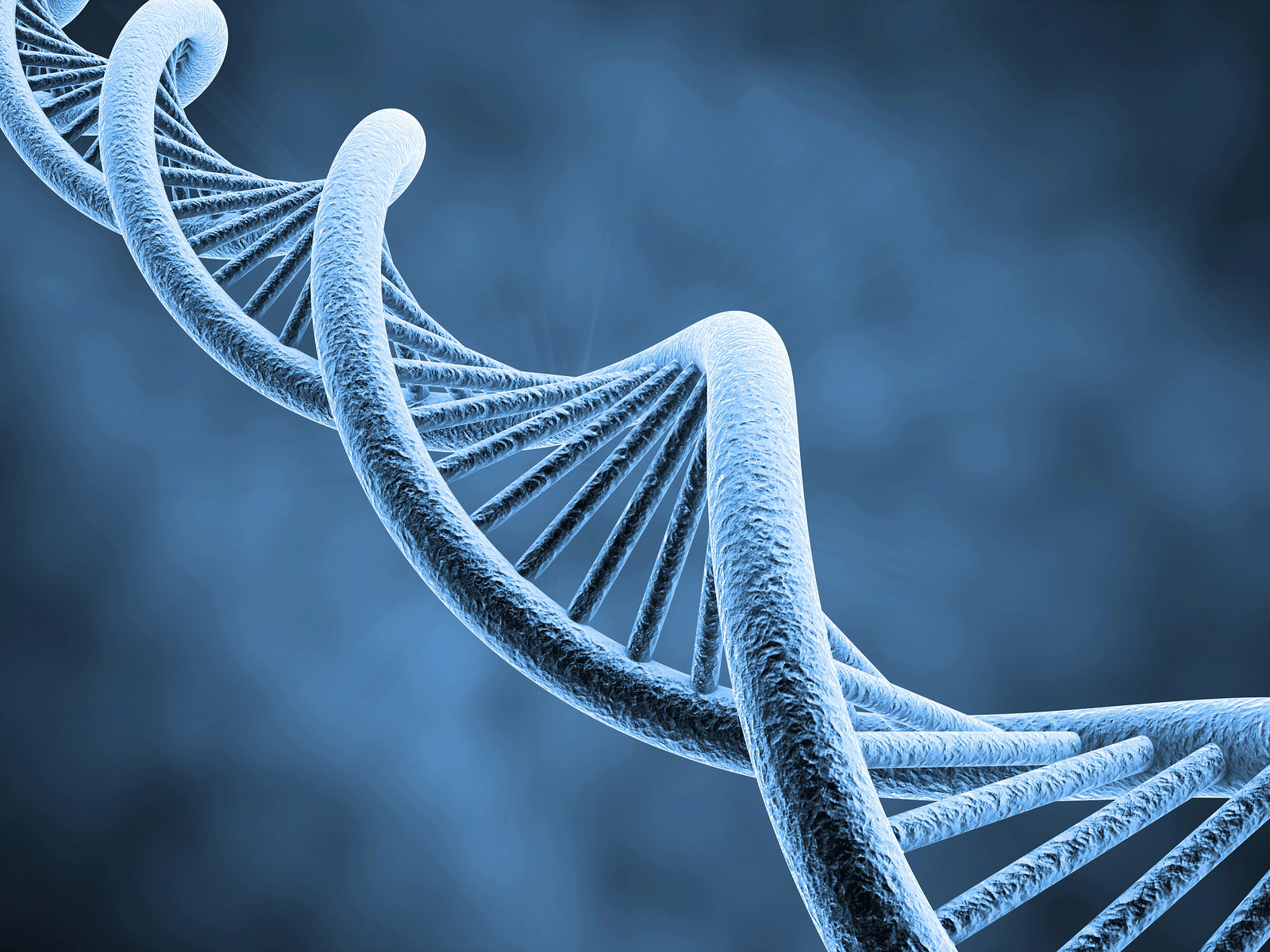
The double helix strand of DNA (bigstockphoto.com)
CURWOOD: Wait a second. This sounds a little like teleporting.
VENTER: Well, we call it biological teleportation, but it’s not like a “beam me up, Scotty,” it’s sending the instructions or the information, in this case, the DNA software is sent as digital information and converted back into the chemical software, and we’re doing that now on Earth, but it’s not a huge leap to think about doing it between planets. And we’re trying to use that for even more important applications in terms of new ways to distribute vaccines that head off future pandemics.
CURWOOD: So you’re able to, in essence, sequence the genes of I guess, a single-celled organism at this point, you’re talking about, and then electronically send that sequence information to someplace else, and then the chemicals can be assembled to recreate that organism, without actually having the organism in the first place ever get to the destination.
VENTER: Exactly. That’s what we’re currently doing, and it’s even had a real world test with the outbreak of the H7N9 flu in China. Chinese scientists sequenced the flu virus associated with the outbreak and posted it on the internet. At the request of the US government, we downloaded that digital sequence and recreated the H7N9 flu to develop a vaccine and, for a long time, it was the only source that CDC, the US government, and our collaboration with Novartis had, and it didn’t entail sending an infectious agent through the mail, it was just downloading digital information.
CURWOOD: When would it be possible to sequence a single fertilized, say, human embryo at the single-cell stage, transit it electromagnetically with radiowaves, say to a nearby star and then have a human grow out there?
VENTER: Well, all except for the last part of the “human grow out there” is possible today. What happened when we first sequenced the human genome - all that has been digitized and spread around through the internet for almost 15 years now - but we don’t know how to make large pieces of DNA like the human genome. What we made was 1.1 million letters. The human genome is six billion letters and complex chromosome structures. So I think we’re a long way from the technology to rewrite the human genetic code.
CURWOOD: Where do you see your research in the world of synthetic biology being, say, in five or ten years from now?
VENTER: Well it’s moving at a much faster pace with various governments around the world investing very heavily in this. I’m hoping our own government will do the same, but one of the things that gives me great optimism is there’s tremendous effort with high school and college students where they naturally understand the exchange between the digital world that they grew up with and the biological world, and have come with numerous pretty amazing little inventions of creating the equivalent of electronic circuits out of biology, and I think this is going to be the future of a tremendous amount of design and probably inventions I can’t even envision right now myself. But we’re trying to drive the applications in some of the key areas in synthetic genomics towards new food production, new vaccines and that type of .. microbial production and potentially even fuel production from sunlight and CO2 in the future.
CURWOOD: By the way, when you mention food, what do you mean exactly?
VENTER: So, for example, we’re working with a number of naturally occurring, photosynthetic algae microbes that we’ve obtained from the ocean and in other places that we’ve encouraged some through selection and some through engineering to produce much higher amounts of, for example, the omega-3 fatty acids as major food supplements that are currently obtained primarily from large amounts of fish. It’s known as fish oil, when in fact, it’s algae oil that fish get by eating the algae. So we’re trying to eliminate the middle species and just go right to the algae for the source. But also, we can get much better sources of protein than we can from existing plants and animals in a much more productive fashion than trying to use cattle to produce steak, which each kilogram of steak requires 20,000 liters of water and a substantial amount of feed. So it’s clearly not sustainable, and we can get much better more nutritious proteins and oils by making them using algae cells for example.
CURWOOD: Craig Venter, your plate seems impossibly full. It seems like you’d have to live forever to follow all the channels that you’ve opened here.
VENTER: Well, we’re trying to take on projects where we can see results in my and my colleagues’ lifetimes, but we hope to have the science set off in a new direction that can hopefully help the survivability of our species long into the future.
CURWOOD: Craig Venter is the founder of J. Craig Venter Institute and his new book is called “Life at the Speed of Light: From the Double Helix to the Dawn of Digital Life”. Thanks so much for taking the time with me today.
VENTER: I enjoyed it. Thank you for your thoughtful questions.
Related link:
J. Craig Venter Institute
[MUSIC: Synthetic Biology: Kris Bowers “Wake The Neighbors” from Heroes & Misfits (Concord Music 2014)]
CURWOOD: Living on Earth is produced by the World Media Foundation. Naomi Arenberg, Clairissa Baker, Bobby Bascomb, Emmett Fitzgerald, Helen Palmer, Catalina Pire-Schmidt, Adelaide Chen, James Curwood, Jennifer Marquis and Gabriela Romanow all help to make our show. Jeff Turton is our technical director. Alison Lirish Dean composed our themes. You can find us anytime at LOE.org, and like us on our Facebook page - it’s PRI’s Living on Earth. And we tweet from @LivingOnEarth. I'm Steve Curwood. Thanks for listening.
ANNOUNCER 1: Funding for Living on Earth comes from the Grantham Foundation for the protection of the environment. Supporting strategic communications and collaboration in solving the world’s most pressing environmental problems. The Kendeda Fund, furthering the values that contribute to a healthy planet, and Gilman Ordway for coverage of conservation and environmental change. Living on Earth is also supported by a friend of The Nation, where you can read such environmental writers as Wen Stephenson, Bill McKibben, Mark Hertsgaard and others at TheNation.com. This is PRI, Public Radio International.
ANNOUNCER 2: PRI, Public Radio International.
Living on Earth wants to hear from you!
Living on Earth
62 Calef Highway, Suite 212
Lee, NH 03861
Telephone: 617-287-4121
E-mail: comments@loe.org
Newsletter [Click here]
Donate to Living on Earth!
Living on Earth is an independent media program and relies entirely on contributions from listeners and institutions supporting public service. Please donate now to preserve an independent environmental voice.
NewsletterLiving on Earth offers a weekly delivery of the show's rundown to your mailbox. Sign up for our newsletter today!
 Sailors For The Sea: Be the change you want to sea.
Sailors For The Sea: Be the change you want to sea.
 The Grantham Foundation for the Protection of the Environment: Committed to protecting and improving the health of the global environment.
The Grantham Foundation for the Protection of the Environment: Committed to protecting and improving the health of the global environment.
 Contribute to Living on Earth and receive, as our gift to you, an archival print of one of Mark Seth Lender's extraordinary wildlife photographs. Follow the link to see Mark's current collection of photographs.
Contribute to Living on Earth and receive, as our gift to you, an archival print of one of Mark Seth Lender's extraordinary wildlife photographs. Follow the link to see Mark's current collection of photographs.
 Buy a signed copy of Mark Seth Lender's book Smeagull the Seagull & support Living on Earth
Buy a signed copy of Mark Seth Lender's book Smeagull the Seagull & support Living on Earth

